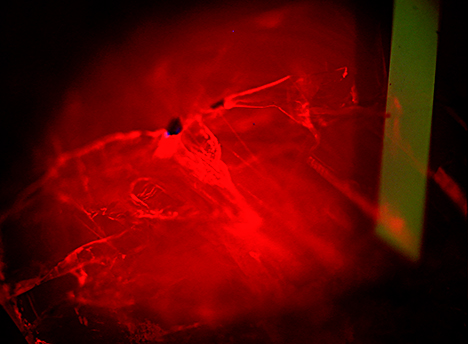An Unusual Filled Ruby

A 12.12 ct corner-cut rectangular red stone (figure 1) was submitted to the Laboratoire Français de Gemmologie (LFG) for analysis. The sample’s refractive index, specific gravity, and Raman spectrum confirmed its identity as a ruby. It fluoresced a medium to strong red in long-wave UV radiation, and a weaker red in short-wave UV. Under magnification, it showed fairly dense accumulations of long needles, some of them rather flat and most of them iridescent (figure 2). Many parallel twin lamellae crossed the gem (figure 3). There was no indication of thermal enhancement. The inclusions and chemical composition were consistent with ruby from Myanmar.


Many fractures were apparent, with smaller ones following the twin lamellae. Examining the surface of the fissure, it became apparent that some material was present inside the fractures, and in some locations had left a whitish trace in the fracture close to the surface. Deeper within the fractures there were flat bubbles and networks of cracks similar to those seen in drying mud, with a somewhat dendritic aspect.
These same patterns were observed with the drying of oil in emerald (H. Hänni, “Gemmology, an oil well in your garden?” Schweizer Uhren & Schmuck Journal, No. 3, 1988, pp. 461–464; H. Hänni et al., “How to identify fillings in emeralds using Raman spectroscopy,” Jewellery News Asia, No. 145, 1996, pp. 154–156). Under the heat of the optical fiber used for observation, some droplets formed at the outcrop of the fissure, indicating that the material was either liquid or had a melting point just above room temperature, suggesting that the filler could be either oil or wax.
Exposure to the ultra-short UV wavelength of the DiamondView revealed the filling material inside the fractures (figure 4). Infrared absorption confirmed the presence of an organic material in the fractures (figure 5). “Oil” peaks at about 2852, 2925, and 2955 cm–1 were at positions nearly identical to those observed for oil-impregnated emerald (P. Zecchini and P. Maitrallet, “Que peut apporter la spectrographie infrarouge dans l’étude des émeraudes?” In D. Giard, Ed., L’émeraude: Connaissances Actuelles et Prospectives, Association Française de Gemmologie, Paris, 1998, pp. 81–96; M. Johnson et al., “On the identification of various emerald filling substances,” Summer 1999 G&G, 82–107). The peaks were accompanied by sharp features around 3600–3700 cm–1, attributed to kaolinite group minerals (A. Beran and G. Rossman, “OH in naturally occurring corundum,” European Journal of Mineralogy, Vol. 18, 2006, pp. 441–447). The band at 2463 cm–1 was produced by CO2.


On the basis of microscopic observation and infrared spectroscopy, we concluded that the ruby showed moderate indications of clarity enhancement—with oil, in this case. Although glass-filled rubies are common on the market today, oiled corundum is much rarer. This oiled ruby was also unusual for its size and evidently Burmese origin.



